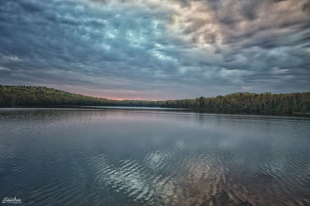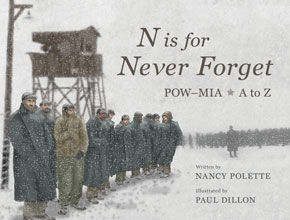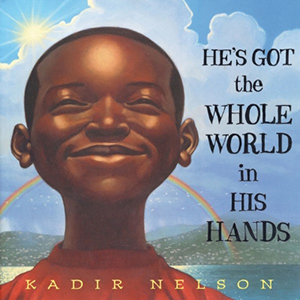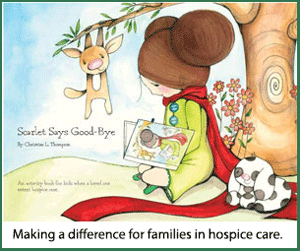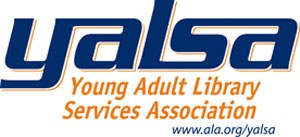Minnesota history is written in the landscape. Rolling hills, grasslands, woods, and water are as much a part of the history as the people who have called it home. Ancient burial mounds are part of the Minnesota landscape too, and they are also part of a larger story of the Dakota people in Minnesota. Like the mounds, much has happened to the story of the Dakota people. Europeans settled and without understanding the importance of the culture they were impacting, treaties were written, lines were drawn, people were exiled, mounds were leveled, and over time other sacred landmarks have been hotly contested for development. Until the recent publication of the award-winning history book Mni Sota Makoce: Land of the Dakota, a Dakota version of their history in Minnesota has been too often misrepresented.
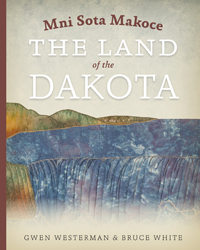 Coauthor Gwen Westerman, a Dakota woman who is an artist, poet, and scholar as well as a professor at Minnesota State University in Mankato, explains, “I want [people] to know that Minnesota is a Dakota place and that it is still a Dakota place. It is marked by our history, as a people. It is marked by our culture and it is marked by our language.”
Coauthor Gwen Westerman, a Dakota woman who is an artist, poet, and scholar as well as a professor at Minnesota State University in Mankato, explains, “I want [people] to know that Minnesota is a Dakota place and that it is still a Dakota place. It is marked by our history, as a people. It is marked by our culture and it is marked by our language.”
The Dakota have a strong oral tradition, and because the history hadn’t been written down, their story became largely a reflection of misinterpretations, poor translations, omissions, and oftentimes singular points of view. The Dakota story suffered.
Bruce White, coauthor and owner of Turnstone Historical Research, says, “Some people suggest that because there are biases in the telling of history, that history isn’t worth anything and that there’s no truth. I do believe there is truth and there are truths. The point of getting multiple versions is to get richer truth.”
In order to provide the Dakota version of their history in Minnesota, Gwen and Bruce worked with a team of collaborators to sift through the layers of history and hurt to bring forth an uncovered story—this time from a Dakota point of view. Seeking that richer truth, Gwen and Bruce sought the Dakota version that is missing from many generally-accepted historical accounts of the Minnesota story. Gwen led the group that collected the oral tradition stories of the Dakota people, and Bruce directed the research of primary sources, including written documents, treaties, journals, maps, and art. The finished product was the book, published in 2012 by the Minnesota Historical Society Press. Their work is changing the conversation about the Dakota people in Minnesota.
The Dakota Relationship With Land
The name Minnesota comes from Dakota people who named their homeland Mni Sota Makoce. In translation, the name means “Land Where the Waters Reflect the Clouds.” It is a beautiful and accurate description of the land in Minnesota, but for the Dakota people it is more than just a place or a name. The Dakota people have a deep relationship with land, and understanding that relationship is an important part of the motivation to publish this book.
Over the course of history, the story has been told, written, manipulated, and accepted to reflect the European version and perception of Minnesota history.
“You have to leave open the possibility that there are multiple points of view,” Bruce says, “even if they are not recorded in documents.” He acknowledges the power of bringing those unrecorded versions into the historical record. He admits that as a historian, “Even the best written history is sometimes full of stereotypes about native communities, so to be able to work on this project with Dakota people, we try to look at it from the Dakota point of view. That was a really exciting thing to be asked to do.”
Writing down the Dakota perspective adds validity to their history.
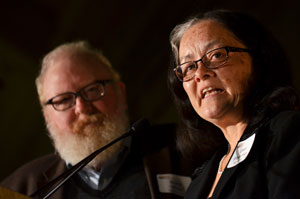
Gwen Westerman and Bruce White talk about the importance of their work collecting Dakota history from a Dakota point of view.
Gwen says, “Now there is a published history of Dakota people in this place with Dakota sources, with French and British sources that back up what we believe is truth, that we have been in this place long before anyone else ever came here.”
Bruce says, “So much of what Europeans wrote down were misinterpretations. Faint reflections of Dakota meanings, but they were not directly representative of Dakota meanings. There was a tension between the written record and oral tradition.”
Bruce hesitates to consider the findings in the European writings as confirmation of Dakota truths. He explains that what is written are also reflections, but they do add layers to the full story.
For instance, Bruce says, “There are people who claim that the Bdote creation stories were made up in the 1990s by activists, yet we have a story from 1720 which reflects that same belief.”
Capturing and Writing Oral Traditions
One of the most important parts of this project was to put into writing the Dakota perspective. For two years, Gwen and her team of researchers collected the stories.
Their initial contacts connected them with tribal historians who seemed to be repeating what they had learned in European-version history books. Gaining access to the story holders meant connecting with the people most tied to the traditional Dakota lifestyle and it required a more traditional approach.
Gwen says. “(The story holders) tended to be people who were speakers of the language, people who had been raised by their grandparents who heard their grandparents tell these histories and these stories, and once the word got out that we were working on this project, it was fairly easy to talk to people.”
Equally effective to tracking down the longest-standing oral traditions was gaining the trust of the storytellers.
“When we would go meet with somebody,” she says, “we would bring gifts and we would sit and talk. We would talk a little bit about the project, and then we said, ‘we’ll come back and if you’d like to talk to us, you can tell us those stories when we come back.’”
Establishing relationship is the Dakota way, and collecting and publishing Dakota stories is a validation of a culture that has been omitted from the accepted history of Minnesota.
Gwen says, “To see the book and to see their names in the back of the book being credited as sources that are just as important as published sources that have been out there for years meant a lot to them.”
Gwen wove the stories together and she says, “I wanted the first chapter to read like Genesis. This is our story — from one voice — for everyone.”
Gwen’s Foretelling: A Bridge for the Dakota People
One of the first years Gwen lived in Mankato, in the early 1990s, a colleague at the University invited her to go see the Native Americans who were coming to town on December 26. She and her friend watched the midnight runners run into Mankato in honor of the 38 Dakota killed by hanging in 1862.
In the parking lot before she left the event, she says, “I had an experience that I didn’t know how to explain. My stomach came up and I started weeping and I didn’t know why. I called my uncle and told him and he said to me that I was connected to this place in ways that I did not yet understand.” He told Gwen she was going to be a bridge for the Dakota people. “This book is part of that,” she says.
Gwen says, “We all have these experiences in places that speak to us in one way or another, it’s just a matter of being still long enough to make that connection.”
Town after town, lake after lake in Minnesota, the names given have their origin with the Dakota people. Landmarks, towns, lakes and rivers are not just a part of the landscape to the Dakota, however. Those physical places are members of their family.
Gwen hopes the book will change the way Minnesotans view the land they call home.
“How differently we would treat this place if we treated it as our relative instead of as a commodity: something we’ve bought and sold, or thrown away, used, and transferred,” Gwen says.
Traveling the landscape from Nebraska to Manitoba to collect the Dakota stories gave Gwen a greater appreciation for her past, her place as the bridge between that past, and where the story will go from here.
“There were times in all the places we went where I was caught up in a moment in that place. It was as if the land was calling to me to pay attention. I understand now how we can be connected to a place that is so large, yet so familiar.”
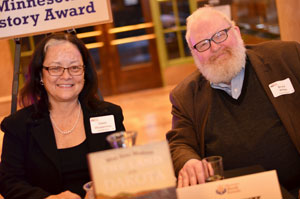
Gwen Westerman and Bruce White won the Minnesota Book Award for Mni Sota Makoce: Land of the Dakota.
Grateful for the platform to document a credible Dakota history, Gwen and Bruce both believe this book will be the start to many more writings about the Dakota culture. Gwen is currently working on a historical fiction book, and Bruce thinks it is a necessary step to presenting a richer truth of the Dakota past.
He says, “In order to change people’s minds, you have to have a better story to tell them. So, tell a better story.”
This history book is opening the path for people to tell a better and richer story about the Dakota people and their homeland by adding the Dakota voice to the written word.
AWARDS:
American Association for State and Local History 2013 Award of Merit
2013 Minnesota Book Award in the Minnesota category
2014 Hognander Minnesota History Award
Buy from Minnesota Historical Society Press or Amazon or your favorite Indie Bookstore
Facebook: /MinnesotaHistoricalSociety
Twitter: @MNHS
Feature photo credit: Trout Lake by Saundra’s Photography
Inset photos courtesy of The Friends of the St Paul Public Library.
Meagan Frank is an award-winning writer and inspiring speaker based in Wisconsin. She is the author of the Choosing to Grow series and is working on her first novel. www.MeaganFrank.com

